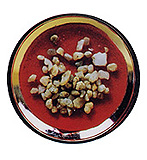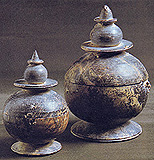| |
| ◎From
the Stupa to the Pagoda│1│2│3│4│ |
|
A.
Origins of the Stupa
(A)Relics
According to Buddhist sutras, after the
Buddha's parinirvana more than 2,500 years ago, his body was cremated
by his disciples according to the custom of the time. Found among the
ashes were corporeal remains of the Buddha in different shapes, sizes
and colors, known as the Buddha's “relics.”
Because people can no longer see the “true body” of the Buddha since
his departure from the human world, disciples and devotees who miss him
dearly revere and pay homage to his relics as if they were his true body.
 |
 |
 |
 |
| corporeal relics of the Buddha and eminent monks
after cremation |
the Bodhisattva statue is holding
the finger relic of the Buddha in his hands, which was reverently
escorted from Xian, China to Taiwan |
the tooth relic of the Buddha, Fo Guang Shan Monastery,
Kaohsiung, Taiwan |
excavated from India, these soap-stone
reliquaries were believed to be housed in a stupa built by the Buddha's
clansmen |
(B)Origin
of the Reliquary and the Building of Stupas for Paying Homage to the Buddha
During the Buddha's time, India was composed of many small states.
After the parinirvana of the Buddha, eight states sought to enshrine the
precious relics in their land. As war was about to break out, the Brahmin
Drona made the suggestion to divide the relics eight ways. Since each
state would receive a share of the Buddha's relics to make offerings to,
the conflict was settled peacefully.
After receiving the Buddha's relics, each of the eight kings reverently
made exquisite containers or reliquaries to house them. Stupas were also
built as offerings to the relics. Thereafter, Buddhist stupas became a
place for Buddhists to pay homage to the Buddha and to remember him.
B.
Shapes and Structures of the Stupa and the Pagoda
In India, the stupa was originally an actual sepulcher, placed over
a reliquary containing the Buddha's relics. Two hundred years after the
Buddha's parinirvana, India saw the rise of the great King Asoka who unified
the country. He constructed 84,000 stupas to actively disseminate the
teachings of the Buddha. Ever since, the stupa became a symbolic monument
for all Buddhists as they remember the Buddha.
Although the stupa had its origin in India, it developed into many different
forms as it spread across the world. The various types of stupa that are
seen today in many different countries are results of combining the features
of the original Indian stupa with local architectural styles.
No matter how magnificently splendid,
gracefully unblemished, or simply elegant a stupa or a pagoda may be on
the outside, it is always unique in its features as there are many types—the
inverted alms-bowl stupa, the multi-storey pagoda, the close-eaved pagoda,
the single-storey pagoda, the Tibetan-style dagoba, and the diamond-throne
pagoda (cf. pullout, “Illustrated World Buddhist Arts, Selected Edition”
for detailed descriptions).
Whether it is a stupa or a pagoda of
the various types, it is composed basically of a steeple, a body and a
base, but for many of the Chinese multi-storey pagodas, an underground
chamber is also built beneath the pagoda's base.
 |
|
|











